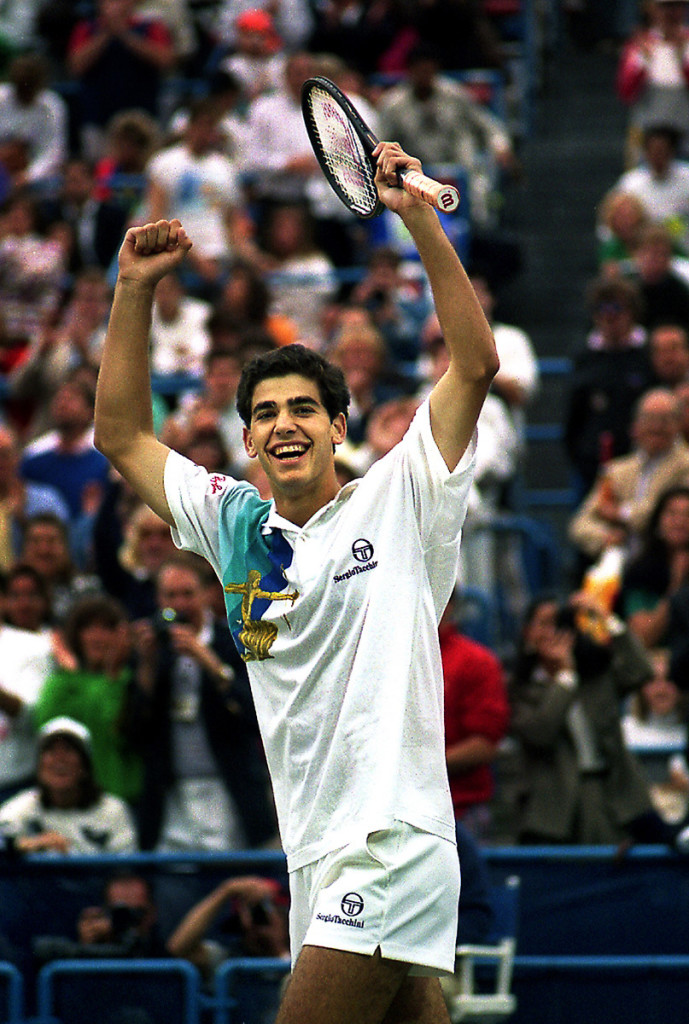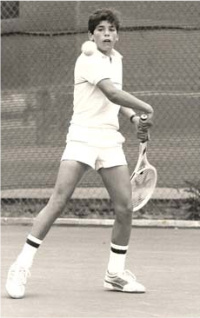As the sun sets on the last weekend of the US Open tennis tournament just outside Manhattan, it marks the bitter end of summer. As a kid growing up around New York and playing my fair share of tennis, the game was religion and Flushing Meadows was the temple. As the US Open comes to an end, I always think back to Pete Sampras’ success there — at age 19, he took the city by storm beating Andre Agassi in 1990; then, 12 years and 13 grand slams later, he beat Agassi again for his 14th, a record at the time.
Tennis fans know of Sampras’ greatness, but I was extra (un)lucky — I played competitive youth tennis during the same time as Sampras, Agassi, Chang, Courier and many other great future pros. Back in the early 1980s, each year I’d fly down to Miami to play in the Easter Bowl. Several rounds into the event one year I was up against a strong, but younger, player from Southern California – as I recall, I had just turned 15 and he was 12 going on 13. He was lightning quick, wielded a two-handed backhand, and played baseline tennis. Our styles were similar, but he was just a bit better in every aspect of the game. I lost a tough match to Pete Sampras that day.
Fast forward to the summer of 1986. I was in Kalamazoo, Michigan, playing the Boy’s 18 & Under National Championships as a 17 year old. Seeded 11th and having advanced my game in the few years since my match with Pete, I made the quarter-finals, defeating the 4th seed along the way, helping me land a partial college scholarship. Meanwhile, then-15 year old Pete Sampras went into the draw UNSEEDED and LOST in the first round to another unseeded player, Don Johnson (a future Wimbledon doubles champion). Pete had changed his game dramatically – he was now hitting a one-handed backhand, serving big and rushing the net at every opportunity. With all these new features to his game, his level of play suffered, as did his ranking that year.
That was 1986. Four years later in 1990, Sampras entered the U.S. Open in late August as a 19-year old, serving and volleying his way through past and future champions like Agassi, John McEnroe, and Ivan Lendl on his way to the title. Pete’s early ascendency in the U.S. junior tennis scene, his subsequent rapid drop, and remarkable re-ascendancy in the pro tennis world is hard to fathom. What happened? And, what can entrepreneurs learn from Pete’s ascension to greatness?
- Rebuilding From Good To Great, And Great To Greatest. Pete was a childhood phenom. Growing up in the same era as Agassi, Courier, and Chang, he was the most talented of that bunch. In his early teens, he was the most promising player in the country, yet he opted to radically change his style. He knew making this switch would result in a rapid decline in ranking, causing him to drop well below his rivals — like he did in the ‘86 tournament. There was no guarantee the gamble would pay off either. Had Pete stuck to his all-court, two-handed backhand approach, he was on a trajectory to become a Top 10 player in the world – but Pete had bigger goals in mind, and he was willing to risk everything to go for it, to be the best player he could be. He had the conviction to knowingly take a step back with the belief that it would help him to ultimately advance further. This is also a rare skill in companies. Netflix founder and CEO, Reed Hastings, famously values employees who take smart risks. There have been many doubters when Netflix has announced new initiatives such as streaming, original programming, and international expansion. Like Pete, Netflix has been willing to take big risks to try to achieve an ultimate goal. Now both Pete and Reed are heading to their respective hall of fames.
- The Independent Drive To Make Courageous Decisions. To this day, the Sampras’ serve is still widely viewed as the greatest in tennis history, yet his serve as a younger player was not great. Similarly, Pete’s volleys, which were among the best ever in the game and set him apart during his pro career, but weren’t even a part of his game plan as a young player. The power game of serve & volley he developed was only possible due to the courage he displayed to make radical changes to his style. There wasn’t anything subtle about these changes – Pete completely rebuilt his arsenal by making the hard decisions necessary to do so. He knew where he wanted to be and he showed the courage to expose weaknesses in order to get there. Back to entrepreneurs, Mark Zuckerberg has taken decisive and radical actions at Facebook, despite taking the company public and making lots of money. Even most recently, Zuckerberg hasn’t taken the convenient path. His bold acquisitions of Instagram for $1B, WhatsApp for $19B, and Oculus for $2B were each derided initially as being too expensive, unnecessary and/or off-strategy. But, Zuckerberg, like Pete, has a clear view of the long game, and he’s not going to let anyone stand in his way of achieving his vision.
- Build Your Team & Believe in Them. Pete, even at a young age, always surrounded himself with coaches that challenged him but showed him the way. He believed in them and stuck with them, making moves when appropriate. From Lansdorp to Fischer to Tom Gullickson and finally to Paul Annacone, Pete had a small number of intensive coaching relationships that took him all the way through his career. He put his trust in his coaches, unlike today’s pro tennis game, where most coaches are on an ever-rotating carousel among different players. Likewise, entrepreneurs like Steve Jobs similarly built very deep relationships with several long-term execs at Apple. Tim Cook and Jony Ive, who’ve worked at Apple a combined four decades, jump to mind as the type of people Jobs wanted around him, and now, with Steve sadly gone, they’ve stepped in to help propel Apple forward in the post-Jobs era.
Sampras is long gone from the top of the tennis heap, but watching old footage of him, one can see that in his prime, he’d still undoubtedly compete successfully with the likes of Federer, Nadal, and Djokovic. His long term plan, the risks he was willing to take to be #1, and his longstanding faith in his team were all integral to his success. Entrepreneurship can often feel like a tennis match: its you, by yourself, on the court, with many people watching, and your opponent feels like the rest of the world. In that context, Sampras is a simple, yet powerful, example from which to learn.

